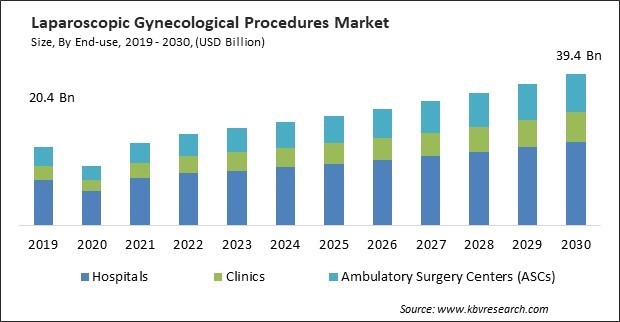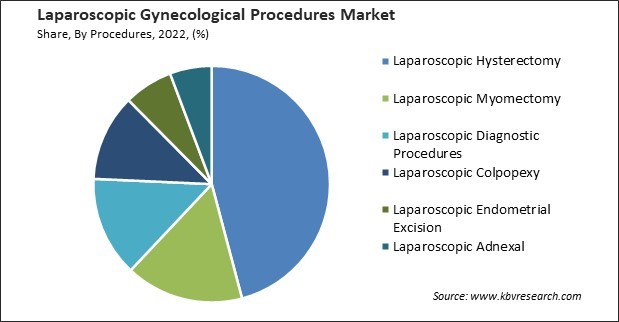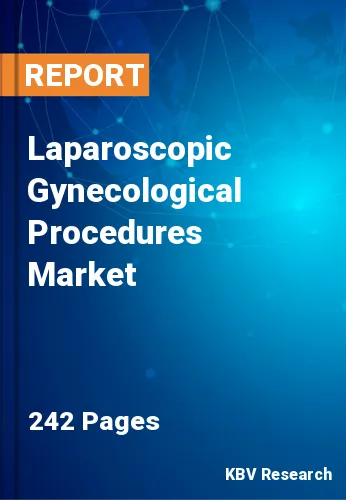The Global Laparoscopic Gynecological Procedures Market size is expected to reach $39.4 billion by 2030, rising at a market growth of 6.6% CAGR during the forecast period.
Laparoscopic hysterectomy involves making small incisions through which specialized instruments and a camera are inserted. This minimally invasive approach results in reduced surgical trauma, minimizing blood loss and tissue damage compared to open surgeries. Therefore, the laparoscopic hysterectomy segment captured $10,932.8 million revenue in the market in 2022. Patients undergoing laparoscopic hysterectomy typically experience quicker recovery times and can resume daily activities sooner compared to those undergoing traditional open hysterectomy. These factors will boost the demand in the segment. Some of the factors impacting the market are minimally invasive surgery trend, technological advancements in laparoscopic equipment, and substantial initial setup and maintenance costs.

One of the primary drivers for the adoption of these procedures is the significant reduction in postoperative pain experienced by patients. Compared to traditional open surgeries involving larger incisions and more tissue disruption, laparoscopic procedures use smaller incisions, resulting in less pain during recovery. Laparoscopic gynecological procedures typically allow for shorter hospital stays compared to open surgeries. The minimally invasive nature of these procedures often enables patients to recover faster and return to their normal activities sooner. Additionally, advanced laparoscopic instruments incorporate innovative features such as articulation, ergonomic designs, and improved handling. These enhancements enable surgeons to achieve greater precision in manipulating tissues and performing intricate maneuvers during gynecological procedures. The result is enhanced surgical accuracy and improved outcomes. Improved laparoscopic imaging systems offer high-definition visualizations of the surgical site. These aspects will boost the demand in the market.
However, laparoscopic procedures require specialized instruments designed for minimally invasive surgery. These instruments need to be high quality to ensure precision and safety during surgeries. The initial investment in acquiring these instruments can be substantial, impacting the financial feasibility of healthcare facilities, particularly those with limited budgets. Laparoscopic surgeries rely on advanced imaging systems to provide clear and detailed visuals of the surgical site. These aspects will lead to decreased demand in the market.
In the early stages of the pandemic, many healthcare facilities globally faced the need to prioritize resources for COVID-19 patients. As a result, elective surgeries, including certain laparoscopic gynecological procedures, were postponed or canceled to conserve healthcare resources and reduce the risk of virus transmission in healthcare settings. The laparoscopic procedures market relies on a global supply chain for surgical instruments and equipment. Supply chain disruptions resulting from lockdowns, travel restrictions, and manufacturing difficulties caused shortages of particular laparoscopic instruments, negatively impacting the accessibility of these instruments for gynecological surgeries.
Based on procedures, the market is segmented into laparoscopic hysterectomy, laparoscopic myomectomy, laparoscopic colpopexy, laparoscopic endometrial excision, laparoscopic adnexal, and laparoscopic diagnostic procedures. The laparoscopic colpopexy segment procured a promising growth rate in the market in 2022. Laparoscopic procedures, including colpopexy, benefit from high-resolution imaging systems that provide surgeons with detailed views of pelvic anatomy. This enhanced visibility allows for the precise placement of mesh or other supportive materials during the procedure. These factors will help in the expansion of the segment.

On the basis of end-use, the market is divided into hospitals, clinics, and ambulatory surgery centers (ASCs). In 2022, the ambulatory surgery centers (ASCs) segment witnessed a substantial revenue share in the market. Patients often prefer the convenience of ASCs for minor surgical procedures. The utilization of laparoscopic gynecological surgeries in an ambulatory environment enables patients to return home the same day, minimizing the inconvenience to their daily schedules and diminishing the necessity for overnight hospitalization.
| Report Attribute | Details |
|---|---|
| Market size value in 2022 | USD 23.8 Billion |
| Market size forecast in 2030 | USD 39.4 Billion |
| Base Year | 2022 |
| Historical Period | 2019 to 2021 |
| Forecast Period | 2023 to 2030 |
| Revenue Growth Rate | CAGR of 6.6% from 2023 to 2030 |
| Number of Pages | 242 |
| Number of Table | 290 |
| Report coverage | Market Trends, Revenue Estimation and Forecast, Segmentation Analysis, Regional and Country Breakdown, Porter’s 5 Forces Analysis, Company Profiling, Companies Strategic Developments, SWOT Analysis, Winning Imperatives |
| Segments covered | Procedures, End-use, Region |
| Country scope |
|
| Companies Included | Medtronic PLC, Stryker Corporation, Karl Kaps GmbH & Co. KG, Johnson & Johnson, Olympus Corporation, ConMed Corporation, B. Braun Melsungen AG, Richard Wolf GmbH, Intuitive Surgical, Inc., and Shenzhen Mindray Bio-Medical Electronics Co., Ltd. |
| Growth Drivers |
|
| Restraints |
|
By region, the market is segmented into North America, Europe, Asia Pacific, and LAMEA. The North America segment procured the highest revenue share in the market in 2022. North America is a hub for technological innovation in healthcare. The region witnesses continuous advancements in laparoscopic instruments, imaging technologies, and robotic-assisted surgical systems. Surgeons in North America have access to cutting-edge equipment, contributing to the increased adoption of laparoscopic techniques. As a result, the segment will grow rapidly in the coming years.
Free Valuable Insights: Global Laparoscopic Gynecological Procedures Market size to reach USD 39.4 Billion by 2030
The market research report covers the analysis of key stake holders of the market. Key companies profiled in the report include Medtronic PLC, Stryker Corporation, Karl Kaps GmbH & Co. KG, Johnson & Johnson, Olympus Corporation, ConMed Corporation, B. Braun Melsungen AG, Richard Wolf GmbH, Intuitive Surgical, Inc., and Shenzhen Mindray Bio-Medical Electronics Co., Ltd.
By End-use
By Procedures
By Geography
The Market size is projected to reach USD $39.4 billion by 2030.
Minimally invasive surgery trend are driving the Market in coming years, however, Substantial initial setup and maintenance costs restraints the growth of the Market.
Medtronic PLC, Stryker Corporation, Karl Kaps GmbH & Co. KG, Johnson & Johnson, Olympus Corporation, ConMed Corporation, B. Braun Melsungen AG, Richard Wolf GmbH, Intuitive Surgical, Inc., and Shenzhen Mindray Bio-Medical Electronics Co., Ltd.
The expected CAGR of this Market is 6.6% from 2023 to 2030.
The Hospitals segment is generating highest revenue in the Market by End-use in 2022; thereby, achieving a market value of $21.7 billion by 2030.
The North America region dominated the Market by Region in 2022 and would continue to be a dominant market till 2030; thereby, achieving a market value of $15.1 billion by 2030.
Our team of dedicated experts can provide you with attractive expansion opportunities for your business.

